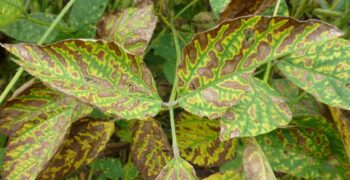Background:
Alfalfa Mosaic Virus or AMV is spread by several species of aphids or mechanical damage to the soybean plant. Infected soybean plants will turn bright yellow and dark green blotchy patterns on the leaf. New growth will be slowed and infected plants will be stunted. Soybean plants that are stunted can produce fewer pods, resulting in yield reduction. Plants that are infected with AMV will not produce seeds with mottled coats, which can happen in other viruses. The seed produced from infected plants can still carry the virus and if the seed is used for production, symptoms can show up early in the following season.
 Scouting:
Scouting:
Symptoms and infection can occur any time during the growing season. When looking to see if your field is infected with AMV, the first place to look is fields that border or are very close to waterways, alfalfa and clover fields. Infected plants will be stunted and have a blotchy bright yellow and dark green pattern on the leaves. Several species of aphids spread the virus, or mechanical damage to the crop can also result in spreading of the virus.
 Management:
Management:
- Best protection against AMV is variety resistance.
- Some varieties will express symptoms more than others.
- There is no in-season control.
- Spraying for aphids to reduce infection has not been effective.



